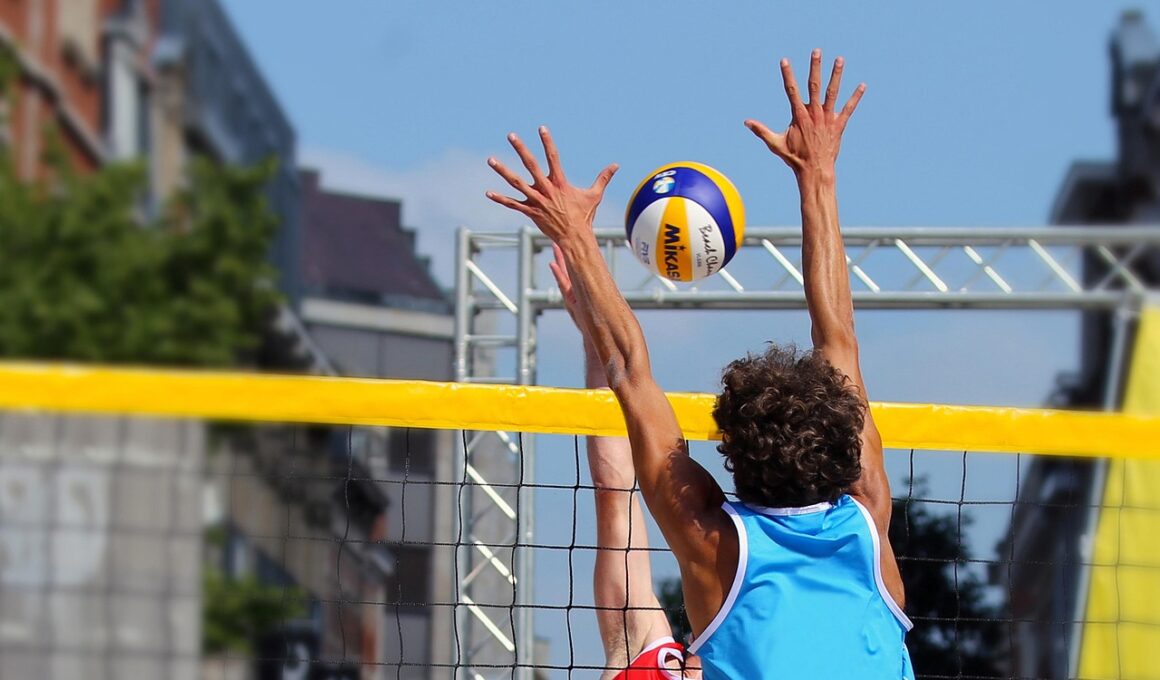The Impact of Hand Flexibility on Volleyball Setting Success
In volleyball, setting is a crucial skill that significantly influences game outcomes. The hands play a pivotal role in this technique, where flexibility often determines the success of setting performances. Flexibility in the hands allows for a more adaptable and responsive approach, enabling setters to adjust to various ball trajectories effectively. This adaptability enhances the setter’s ability to execute accurate and powerful sets, which is essential for successful attacks. By mastering hand flexibility, players can improve their ball control and aim, particularly in challenging scenarios like high-speed plays or unexpected passes. Enhanced grip enables a more confident touch, ultimately leading to better communication with teammates. The relationship between hand flexibility and setting performance cannot be overstated, as proficient setters often show remarkable fluidity and comfort in their movements. Regular exercises designed to increase hand and wrist flexibility can pave the way for noticeable enhancements in setting technique. Therefore, aspiring setters must prioritize flexibility training to boost their overall game, aiming for performance consistency. In this regard, effective training routines that include flexibility exercises are essential components of a setter’s skill development framework, ensuring their readiness for competitive play.
To cultivate optimal hand flexibility, setting drills should blend technique with conditioning. It is essential to incorporate various exercises, focusing on wrist and finger mobility. Trainers can implement movements like wrist circling, finger stretches, and hand flexor strengthening routines, all integral to improving overall hand function. These exercises can be easily integrated into warm-up routines or recovery phases, ensuring that players remain injury-free while enhancing flexibility. Maintaining strong and supple hands allows players to perform techniques like the jump set or back row set with greater precision. Drills must also emphasize quick transitions between different setting styles—such as using soft touch versus aggressive thrust. Engaging in partner drills where players receive sets in different locations trains the hands to adjust under various conditions. Additionally, players should experiment with different ball types and sizes; practicing with a volleyball alongside a lighter ball can significantly develop hand strength and sensitivity. This comprehensive approach ensures that players develop not only flexibility but strength as well, creating a balanced skill set essential for peak performance. Furthermore, involving mental strategy and visual cues additionally propels athletes toward effective execution during competitive scenarios, enhancing overall responsiveness.
Techniques to Enhance Hand Flexibility
Several targeted techniques can significantly boost hand flexibility for volleyball setters. One effective technique involves dynamic stretching routines that prioritize the fingers and wrists. Such strengthening practices not only develop flexibility but also improve overall hand coordination and dexterity, essential qualities for setters. Utilization of resistance bands can also extend the range of motion, engaging various muscle groups within the hands. Setters should focus on the full extension of their fingers while performing stretches, which promotes both strength and flexibility. Another recommended method is the use of specialized hand grips or stress balls, which help strengthen the muscles while enhancing grip flexibility. Exercising regularly with these tools allows athletes to develop better control and sensitivity. Moreover, integrating yoga or Pilates aimed at improving wrist and hand flexibility can take a setter’s skills to the next level. These practices promote overall body awareness, ensuring that athletes maintain a fluid connection between their upper body movements and hand techniques. Consistency in these flexibility routines is critical, as regular reinforcement leads to notable enhancements in technique and performance over time, keeping the players at the top of their game.
Understanding the anatomy of the hands and wrists also plays a crucial role in enhancing flexibility. The hands consist of numerous ligaments and tendons, which can be prone to tightness and injury without adequate care. Setters must be aware of their limitations while practicing flexibility drills, as pushing beyond comfort can result in strains or tendon injuries. Implementing a warm-up routine focused on hand and wrist care is vital; this ensures that players warm up sufficiently before vigorous training sessions. Furthermore, nutrition plays an indirect role in flexibility. Proper hydration and nutrient intake can enhance muscle recovery and promote overall joint health. Athletes should consider incorporating foods rich in vitamins and omega-3 fatty acids, which can help in joint lubrication. Recovery days should also emphasize stretching to preserve flexibility developed over time; hence, cooldown routines post-training must become habitual. Coaches are encouraged to monitor player progress to modify routines according to individual needs, ensuring all players develop secure and responsive hands. Ultimately, striking a balance between strength and flexibility will prepare setters to face the demands of competitive gameplay successfully.
The Role of Mental Readiness in Setting
Alongside physical training, mental readiness significantly impacts volleyball setting success. A set is not merely a physical task; it’s a combination of physical action and instant decision-making. Setters must constantly assess their environment, considering teammates’ positions on the court and the defender’s movements. With increased hand flexibility, a setter may feel more secure when making risky decisions during a match. Developing mental focus and clarity leads to improved anticipation and enables quicker adjustments. Visualization techniques can assist athletes in enhancing their mental preparedness. For instance, players can imagine themselves effectively executing sets successfully, allowing them to feel more confident during crucial match moments. Practicing mindfulness techniques such as deep breathing can reduce performance anxiety, leading to better responsive skills. Discussing strategies in team settings can also enhance communication and promote cohesiveness during gameplay. Engaging in simulations of high-pressure scenarios promotes adaptability, involving both physical skills and mental fortitude. Setters should create a checklist of key aspects to focus on before games, bridging the gap between mental readiness and physical execution. This combined approach empowers setters to optimize their performance on the court, emphasizing the interconnected nature of mind and body in volleyball.
In summary, mastering hand flexibility is undoubtedly essential in achieving success in volleyball setting techniques. The benefits of improved flexibility extend far beyond mere execution, encompassing enhanced control, adaptability, and injury prevention. Setters can significantly elevate their game through rigorous training, incorporating diverse flexibility exercises and preservation techniques. Fostering an environment that prioritizes hand strength along with flexibility prepares athletes to face dynamic game situations. Understanding their anatomical structure empowers setters to promote better care routines, combining physical training with mental strategies uniquely suited to their needs. Attentiveness to hydration and nutrition further enhances recovery and well-being, creating a robust foundation for overall athletic performance. Coaches must also play an active role in guiding players to reach their potential by conducting regular assessments of skills. Integrating group drills that promote collective growth fosters a culture of support among teammates, allowing all players to thrive together. Finally, encouraging an open dialogue about individual challenges and progress can foster a sense of responsibility and motivation. Emphasizing hand flexibility’s impact on setting success will lead volleyball players down the path of excellence, ensuring they meet their athletic aspirations while maximizing their enjoyment of the sport.
Conclusion
In conclusion, hand flexibility is a decisive factor that significantly influences volleyball setting performance. Through a combination of dedicated training, mental preparation, and proper recovery techniques, players can develop the responsiveness needed for elite-level gameplay. As athletes recognize the interconnection between physical abilities and mental acuity, they will be encouraged to pursue continuous improvement in their setting skills. Additionally, fostering a team-oriented atmosphere where players share techniques and learn from one another will inevitably lead to collective success in volleyball. Encouragement from coaches and mentors can also inspire players to embrace flexibility training as an integral part of their everyday practice. Setting is a skill that bridges athleticism and communication; thus, every setter should prioritize the development of their hands. As the sport continues to evolve, the importance of hand flexibility in setting success will remain constant. Ultimately, those who commit to regular flexibility and strength training will experience enhanced game control, better communication with teammates, and a higher level of on-court confidence. Passion for volleyball, coupled with ongoing dedication to skill improvement, will solidify a player’s journey toward excellence within this dynamic sport.
This article emphasizes how critical hand flexibility is to volleyball setting techniques and overall performance. As setters strive to master these skills, they will discover the depth of their potential, paving the way for their teams’ success. By adhering to flexibility as a core focus, volleyball players can cultivate strengths that propel them through competitive matches and toward shared victories. Prioritizing the health of their hands creates a solid foundation that extends beyond merely playing the sport; it fosters personal growth and resilience. With a collective focus on these elements, the future of volleyball settings appears promising, with greater emphasis on flexibility and comprehensive skill acquisition paving the way for success across various levels of play.


